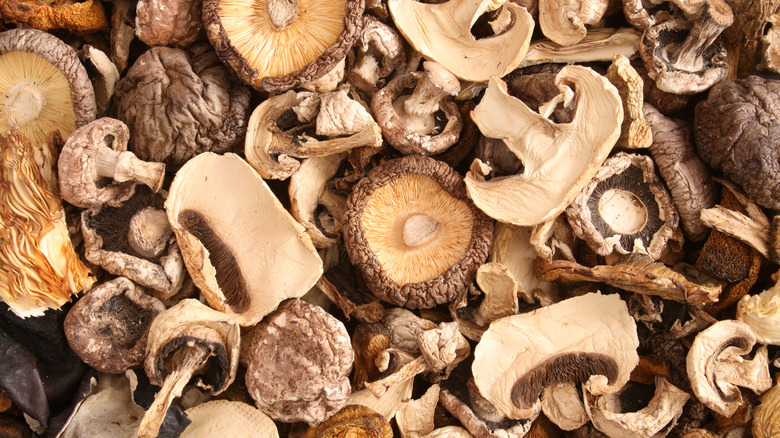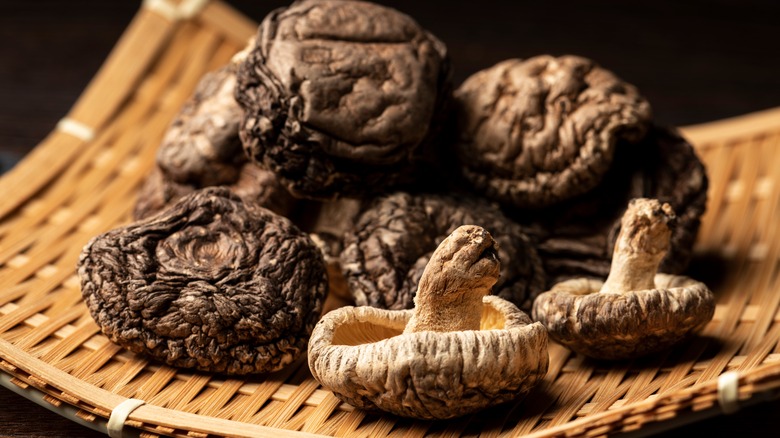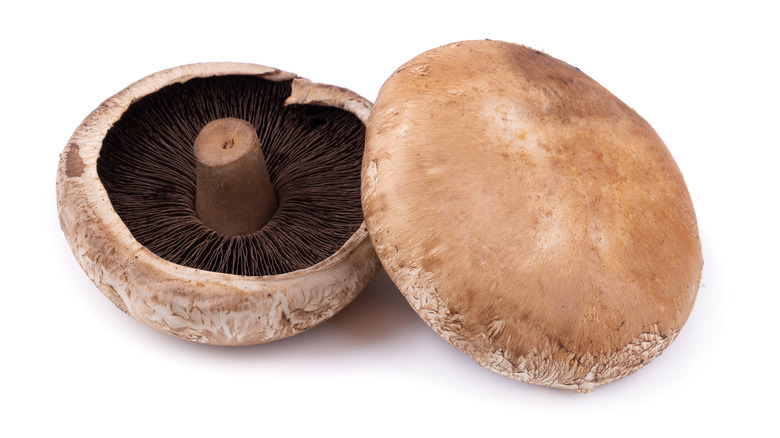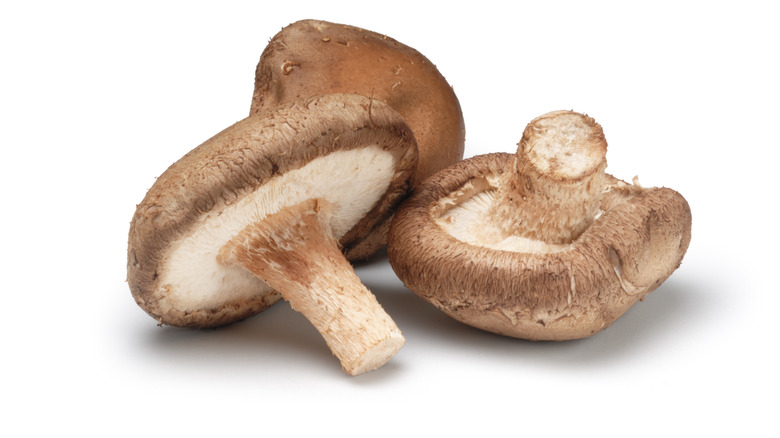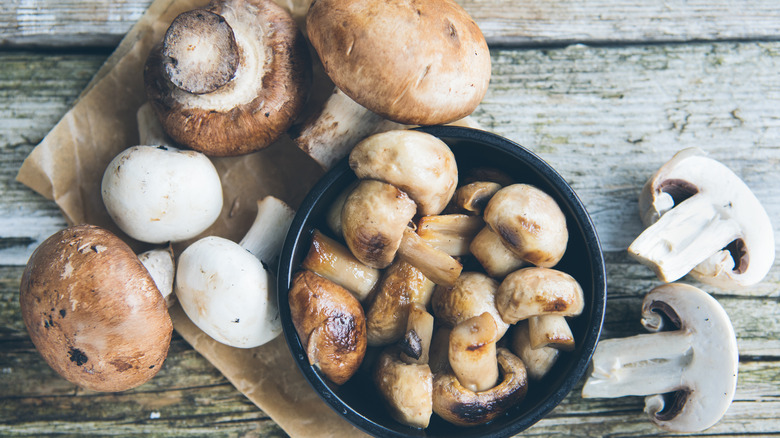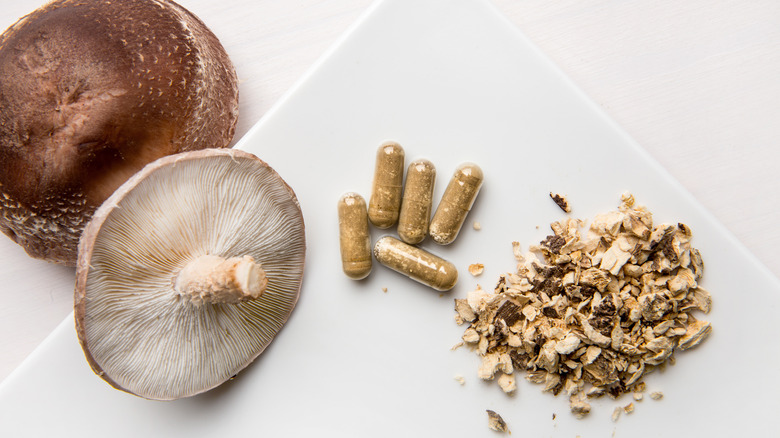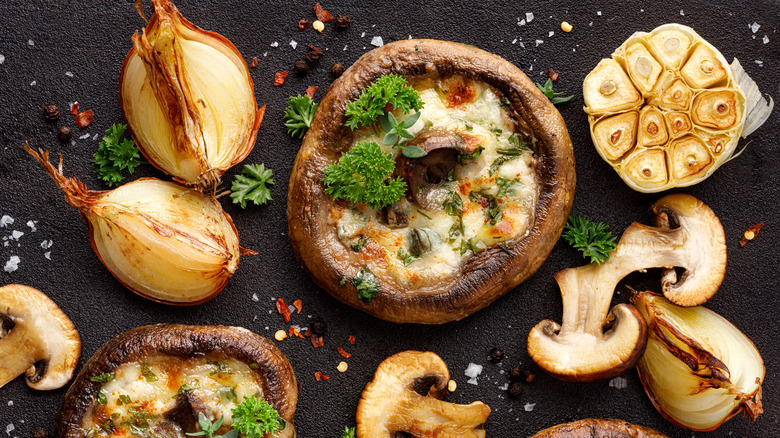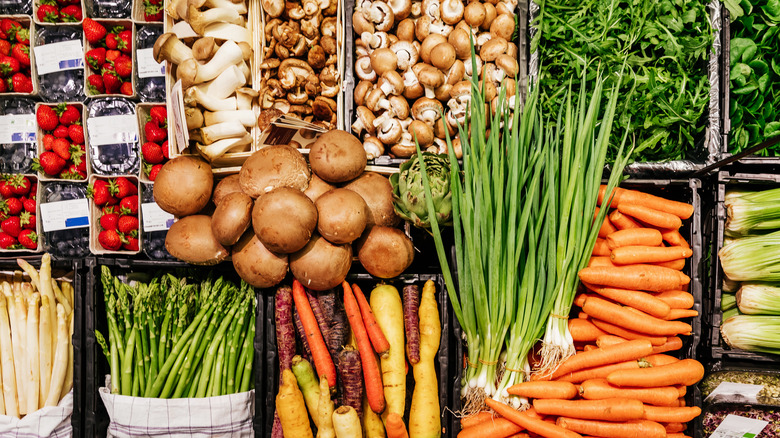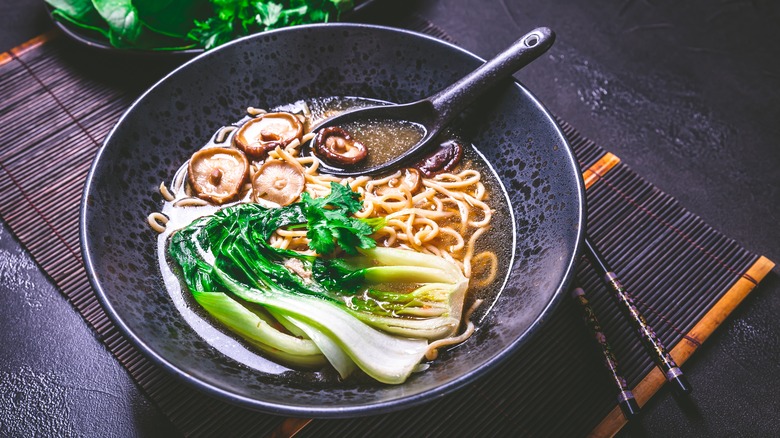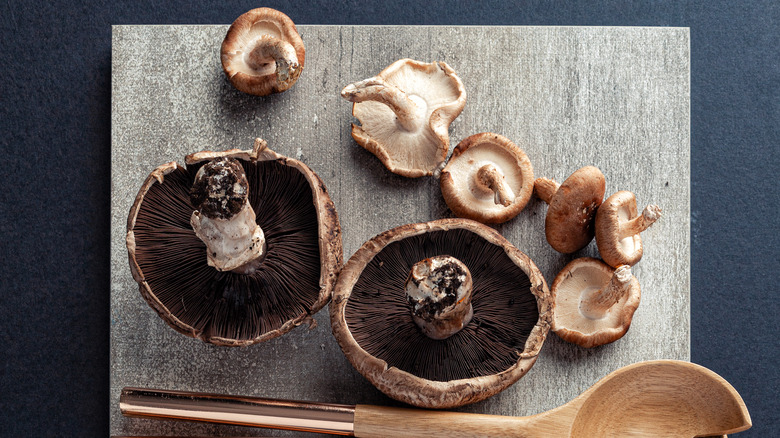Portobello Mushrooms Vs Shiitake: Everything You Need To Know
There's always that one person who wants to switch similar-looking ingredients in a recipe, but when it comes to mushrooms, substituting portobello for shiitake or vice versa can start to feel like a culinary tripping point. What's the real difference between the two?
Over the years, mushrooms have evolved from a vegetarian classic to a kitchen staple found in nearly every pantry. Among the many different mushroom types available in your local grocery store, the two that stand out the most for their incredible flavor, texture, availability, and nutritional benefits are portobello and shiitake mushrooms. Boasting earthy and meaty flavor profiles, as well as delightfully chewy textures, these mushrooms form the base of many favorite Asian soups and stir fries, vegan barbecues, pasta salads, pizza toppings, and much more.
But how can you tell these two fungal delicacies apart? Aside from taste, aroma, and mouthfeel, these two mushrooms differ greatly, including when it comes to the boons they can give to your dishes (and your health). It also remains debatable whether they can be swapped one for the other. So, let's break down their differences and similarities in detail.
They have specific origins
Shiitake mushrooms are native to East Asia, primarily the mountains of China, Japan, and Korea. The mushrooms tend to grow in groups on fallen logs, particularly on the decaying wood of trees. The word shiitake is Japanese in origin, where shii means the specific tree mushrooms grow on and take means mushrooms. These mushrooms have been a prominent part of East Asian culture for centuries, with the earliest varieties cultivated for food and medicine 1,000-1,200 years ago in China (where they're often known as xianggu). Today, shiitake mushrooms are widely cultivated in China, Japan, Korea, the United States, and Brazil for commercial use, making them a favorite ingredient across diverse cuisines. China remains responsible for 80-90% of worldwide shiitake mushroom production.
Portobello mushrooms are native to Europe and North America, where they grow naturally in grasslands, temperate forests, and warm, humid regions. The first record of cultivated Agaricus bisporus dates back to France in the early 18th century, when different varieties of this fungus were grown in tunnels, caves, and quarries (all environment sthat offered increased humidity and control over ambient moisture).
However, their popularity only surged in the United States after 1920, where the white mushroom quickly became a consumer favorite for its clean and pristine look. Today, the common white Agaricus bisporus has become the leading mushroom variety available worldwide.
Portobello mushrooms are large in size with plump, brown caps
Portobellos mushrooms (scientific name: Agaricus bisporus) grow medium to large in size, typically four to six inches in diameter, and are some of the most widely available mushrooms commonly in use today. They appear plump, with domed caps that range from tan to dark brown in color, and have smooth surfaces with occasional scales. Portobellos also have well-developed gills or flaps that become exposed when the cap opens fully, as well as short, light-colored stems and a firm, dense texture. Additionally, the portobello mushroom is one of the largest domestic edible mushrooms that are commonly available today.
Since portobellos are allowed to grow to full maturity during cultivation, they possess a relatively low water content that gives them a meaty taste and chewy texture. The portobello's flavor is often described as umami-like, with deep, earthy notes and an aroma that makes portobello mushrooms a popular ingredient in many recipes. You'll often find these mushrooms as meat substitutes, in pizza toppings, in pasta, and in many salads and sides. Additionally, portobellos are grown year-round (though prime season begins from December and lasts till March), so they remain a staple in most grocery stores, farmers markets, and restaurant menus no matter the season.
Cremini, white (sometimes called button), and portobello mushrooms are actually all the same fungus. While other forms are relatively young versions, portobellos are harvested at the most mature stage.
Shiitake mushrooms are smaller with umbrella-like domes
Shiitake mushrooms (scientific name: Lentinula edodes) are a popular mushroom variety worldwide, featuring light to dark brown umbrella-shaped caps, which range from small to medium in size, and two to five inches in diameter. They have exposed gills beneath their caps, similar to the flaps on a portobello mushroom, and long, cream-colored, curving stems (which should be removed before eating). Compared to portobellos, shiitake mushrooms have a soft and fleshy texture and a smoky, woody flavor and aroma that complements many dishes.
Due to their distinctive flavor profile and rich umami taste, shiitake mushrooms have been used throughout East Asian cuisines for centuries. In the past, people would especially pick wild shiitake mushrooms for their nutritional value, which has a prominent place in traditional herbal medicine in a variety of Asian cultures.
Shiitake mushrooms are consumed both fresh and dried, with the dried variety being a favorite choice among consumers for the concentrated savory flavor it can lend to broths, stews, soups, and braises. Furthermore, shiitake mushrooms, like portobellos, are grown throughout the year so you can source them easily from grocers and organic produce markets, though they may prove to be more expensive.
Portobello mushrooms come from a large fungal family
Portobello mushrooms are the mature form of white button mushrooms and brown crimini mushrooms, making the Agaricaceae family of this particular fungus responsible for 97% of U.S. mushroom production. This also means that they rank number one in mushroom production worldwide (via Colorado State University). So, you can expect to find all types of this mushroo in abundance at your local farmer's market or grocery store. At earlier stages of the portobello's maturity, the brown mushroom has tightly closed caps that are one to three inches in diameter and little to no visible gills. This type is sold as cremini/crimini, baby bellas, Swiss brown, chestnut, or Italian mushrooms, and possesses high water content with woody or earthy flavors.
Portobello mushrooms are also cultivated at an early, immature stage during which they're known as common white or button mushrooms. These mushrooms are similar in appearance to their brown counterparts but with completely closed caps, smooth white tops and stems, and a very mild taste.
It's also interesting to know that the portobello was not the first of its kind to be introduced, and was cultivated when growers took brown crimini mushrooms home to consume or grow as they were undesirable by consumers. Here they grew to full maturity by developing gills and opening their caps all the way. This chance discovery revealed the portobello to the world and it eventually came to be known as the mushroom we all know and love today.
Shiitake mushrooms have more health benefits than portobellos
The two mushroom varieties have similar calorie counts (34 for shiitake and 22 for portobello, per 100 grams) and are high in potassium. Moreover, portobello mushrooms are beneficial to your health as they're packed with dietary fiber and are high in B vitamins, vitamin D, and more thiamin and folate compared to shiitake mushrooms. Additionally, both mushrooms are a great meat substitute for vegans and vegetarians, as they can imitate the fleshy texture and meaty flavors. Both varieties also have similar concentrations of carbohydrates.
However, when it comes to nutritional value, shiitake mushrooms take the clear lead, especially once you learn that they're regarded highly in East Asian cultures for their superior health benefits. They can help to decrease the risk of heart disease by lowering cholesterol, are rich in dietary fiber, and possess lentinan, which boosts your immune system.
Shiitake mushrooms also contain the highest concentration of protein among all mushrooms and have many of the same amino acids as meat. Additionally, they possess vitamin D, copper, fiber, and zinc, and are particularly rich in vitamin B5. According to Healthline, eating just four dried shiitake mushrooms can fulfill a third of your daily intake of this essential vitamin. That's why taking shiitake-based supplements in Chinese medicine is a common way to reap the health benefits associated with this mushroom, though you should check in with a doctor before trying this yourself.
Portobello mushrooms are a popular meat substitute
Many of us today were introduced to portobello mushrooms via the infamous 'Shroom Burger from Shake Shack, which served a cheese-stuffed portobello patty that had been deep-fried and nestled in a soft bun atop a bed of lettuce and tomatoes. Beyond tricky fast food applications, however, portobellos remain a popular stand-in for burgers in restaurants and at cookouts.
Aside from their burger-induced fame, portobello mushrooms remain a vegetarian and vegan favorite for their thick, meaty texture which gives an incredible burst of flavor when grilled as a burger patty substitute or stuffed with fillings and marinades of your choice (which portobellos soak up to perfection!). There are also tons of great mushroom recipes online, for which portobellos are frequently a great choice as they hold flavor well when sauteed, grilled, topped on pizzas, stuffed, added in salads, or cooked as your own take on the portobello burger.
Portobello mushrooms are also not restricted to specific cuisines and spices, as they work well with practically any every flavor combo you can dream up. For example, you can pair portobellos with seasonings such as peppercorn, tarragon, Himalayan pink salt, marjoram, and sauces like Worcestershire and barbecue. For a quick and easy mushroom appetizer that both vegetarian and meat-eating guests will love, make cheesy portobellos stuffed with fried bacon bits, cream and cheddar cheeses, sauteed garlic, and mushroom stems. Now that's a recipe for a guaranteed food coma!
Portobello mushrooms gained popularity in the '80s
The portobello's fame wasn't always so high up in the food scene as it is now, as it had to undergo a marketing campaign around 1980 before it became a popular food choice. In fact, the portobello mushroom was considered an ugly version of the brown crimini mushroom and was often discarded by cultivators because they assumed it would sell poorly. In a scheme to popularize the mushroom by farmers and retailers, it was given the name portobello or portabella, which can mean both handsome port or beautiful door in Italian respectively.
A 1998 piece in The New York Times speaks about portobello's rise to fame at a time when people were shifting to organic and healthier whole food choices. It was also reported in the same piece that after the portobello's popularity, mushroom consumption increased 200% from 1970 to 1994, and 80% of chefs ranked mushrooms in first place among the top 20 chic foods in 1997. Since then, the portobello has been stuffed, seasoned, sauteed, and grilled to perfection by restaurant chefs across the United States. This increasing popularity paired with the growing interest in vegetarianism has made the portobello mushroom a trendy option in recipes for both health reasons and for the unmatched flavor it carries.
Shiitake mushrooms have a higher price point than portobellos
A recent trip to the grocery store will have exposed you to the range of options available in the mushroom section. Whether they're sold fresh or dried, many varieities will have one thing in common — the expensive price tag. This rings especially true for shiitake mushroom prices, which are higher than portobello prices by more than half at major retailers like Walmart. This means that an average meal for four people can cost around $10 in just shiitake mushrooms, putting them in an obviously more exorbitant price category than the portobello.
The price gap is primarily caused by a difference in cultivation, as shiitake mushrooms undergo a lengthier and more laborious growth process known as log inoculation, which can take a whole year to produce fruit. Another method is to grow them indoors using sawdust, which is a more technical process that has high setup costs.
However, despite the price difference, shiitake mushrooms continue to rank third worldwide in mushroom production and remain a favorite choice among consumers, especially for Asian dishes. Additionally, you can find both mushroom types easily in stores like Whole Foods, Kroger, Walmart, your local farmer's markets, and especially Asian markets where shiitake mushrooms are often sold in fresh and dried forms.
Shiitake mushrooms are an umami lover's dream
Aside from their medicinal qualities, shiitake mushrooms are a staple across Asian tables, used fresh or dried in a range of recipes. These mushrooms have a smoky bite to them and a flavor often described as earthy and woody. This lends a flavorsome burst of umami to the shiitake mushroom, making it irresistible in a veggie or meat stir fry, soups, and fried rice. Another beloved classic among shiitake mushroom recipes is vegan mushroom ramen, which captures its complex flavors well in a rich broth. Shiitake mushrooms also serve to enhance flavors when paired with varying ingredients, such as when they are braised with Swiss chard to bring out the chard's spinach-like flavors, put into a hot pot as part of shabu shabu, and even topped on pizza with roasted garlic and taleggio for a unique blend of flavors.
These mushrooms are also often dried before they are added to broths, stews, and braises, as this adds a stronger aroma and flavor compared to the fresh kind. According to MSU Health, drying and rehydrating shiitake mushrooms develops lenthionine, which develops the umami taste that shiitakes are well known for. Before using dried shiitake mushrooms, soak them in warm water for 10-20 minutes and pat dry. If deep frying the mushrooms, be extra sure to dry them with a paper towel to soak up any remaining moisture and prevent them from getting soggy. Also, avoid salting them before frying.
How to properly clean and store portobello and shiitake mushrooms
You don't want to ingest a bad fungus under any circumstances, which is why it's best to properly store and clean your mushrooms before consuming. For portobello mushrooms, remove dirt from under the caps by running them under water or with your fingers, then dry them with a paper towel. Fresh portobellos can be stored in their original packaging or a paper bag for a week in the refrigerator. Portobello mushrooms can be consumed safely from cap to stem so you don't need to remove their stems while cleaning or storing.
Shiitake mushrooms should be washed much the same way as portobellos. Take care to clean the long stems, as they accumulate a lot of dirt and debris during cultivation. Slice the stems off shiitakes and store them separately from the caps as they're only useful in making stocks and broths.
To store fresh shiitake mushrooms, remove them from their store-bought packaging, dry them with a paper towel, and place them in a paper bag. These steps prevent the mushrooms from going bad due to excess moisture and can make them last up to a week in the refrigerator. For dried shiitake mushrooms, keep them in an airtight container in a cool and dry place, away from direct sunlight, in which case they'll last up to a year. If either type of mushrooms gives off a fishy or sour smell, assume they've gone bad and discard them immediately.
Are portobello and shiitake mushrooms swappable in recipes?
Now to address the question most people are looking to answer: can I swap portobello mushrooms for shiitakes and vice versa in recipes? The answer depends on a few factors including the flavor profile you want, your budget, the number of people you're cooking for, as well as more location-specific factors such as availability. Since both mushrooms possess the umami flavor associated with meat, it should be easy to substitute them in recipes where you only need a meaty kick. However, in terms of texture, only portobellos really imitate the chewy mouthfeel of meat, so don't exchange them for shiitakes in recipes like mushroom burgers and portobello steaks.
Moreover, if you're cooking for a party, you'll need to consider your price range, for which more affordable portobellos are an obvious first choice. But if you're hosting an Asian feast, you may want to splurge on shiitake mushrooms as they complement many ingredients used in this diverse set of cuisines. Depending on your location, different mushroom varieties may be harder to find than others. This is especially the case for shiitakes, which aren't always as easy to find in grocery stores. In such cases, swap shiitake mushrooms for the trusty portobello and pray to the culinary gods for a savory success.
Ultimately, to end the debate on which is better, consider what your final dish needs. Use portobello mushrooms as a meat substitute and shiitake mushrooms to enhance your recipe's overall flavor.
